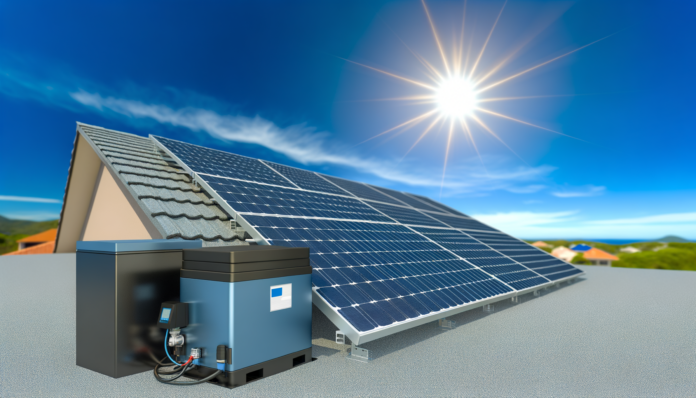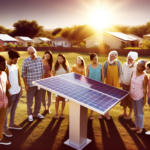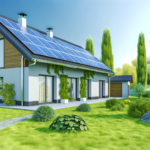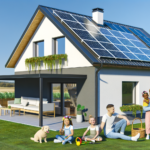Introduction to Solar Power
The Rise of Solar Energy
In recent years, solar energy has experienced a remarkable surge in popularity and adoption. This growth can be attributed to several factors, including advancements in technology, decreasing costs, and an increasing awareness of environmental issues. Solar power, once considered a niche market, has now become a mainstream energy source. According to the International Energy Agency (IEA), solar power was the fastest-growing source of new energy worldwide in 2020, outpacing other renewable sources like wind and hydroelectric power.
Governments around the world have also played a crucial role in promoting solar energy through incentives, subsidies, and favorable policies. Countries like Germany, China, and the United States have invested heavily in solar infrastructure, making it more accessible and affordable for both residential and commercial use. As a result, solar energy is no longer just an option for the environmentally conscious; it is a viable and cost-effective solution for anyone looking to reduce their energy bills and carbon footprint.
Why Solar Power Matters
Solar power is more than just a trend; it is a critical component in the global effort to combat climate change and reduce dependence on fossil fuels. Here are some key reasons why solar power matters:
- Environmental Benefits: Solar energy is a clean, renewable resource that produces no greenhouse gas emissions during operation. By harnessing the power of the sun, we can significantly reduce our carbon footprint and mitigate the effects of climate change.
- Energy Independence: Solar power allows individuals and communities to generate their own electricity, reducing reliance on centralized power grids and fossil fuels. This decentralization can enhance energy security and resilience, especially in remote or disaster-prone areas.
- Economic Advantages: The cost of solar panels and related technologies has dropped dramatically over the past decade, making solar power more affordable than ever. Additionally, solar installations can create jobs and stimulate local economies.
- Scalability: Solar power systems can be scaled to meet a wide range of energy needs, from small residential setups to large utility-scale solar farms. This flexibility makes solar energy a versatile solution for various applications.
Overview of a Solar Power Setup
A typical solar power setup consists of several key components that work together to convert sunlight into usable electricity. Understanding these components is essential for anyone considering a solar installation. Here is a brief overview:
- Solar Panels: These are the most visible part of a solar power system. Solar panels, also known as photovoltaic (PV) panels, capture sunlight and convert it into direct current (DC) electricity.
- Inverters: The electricity generated by solar panels is in DC form, which needs to be converted into alternating current (AC) for use in homes and businesses. Inverters perform this crucial conversion.
- Batteries: To store excess energy generated during sunny periods, batteries are used. This stored energy can be utilized during cloudy days or at night, ensuring a continuous power supply.
- Charge Controllers: These devices regulate the flow of electricity from the solar panels to the batteries, preventing overcharging and extending the lifespan of the batteries.
- Mounting Systems: Proper installation of solar panels requires sturdy mounting systems that can withstand various weather conditions. These systems ensure that panels are securely attached to roofs or ground structures.
In summary, solar power is a rapidly growing and essential component of the global energy landscape. Its environmental, economic, and social benefits make it a compelling choice for individuals and communities alike. Understanding the basic components of a solar power setup is the first step towards harnessing the power of the sun and contributing to a sustainable future.
Solar Panels: The Heart of the System
Types of Solar Panels
Solar panels are the most visible component of a solar power setup, and they come in several types, each with its own advantages and disadvantages. The three main types of solar panels are:
- Monocrystalline Solar Panels: These panels are made from a single continuous crystal structure. They are known for their high efficiency and long lifespan. However, they are also the most expensive type of solar panel.
- Polycrystalline Solar Panels: Made from silicon crystals that are melted together, these panels are less efficient than monocrystalline panels but are more affordable. They have a slightly lower efficiency rate but are a popular choice for residential installations.
- Thin-Film Solar Panels: These panels are made by depositing one or more layers of photovoltaic material onto a substrate. They are the least efficient but are lightweight and flexible, making them suitable for a variety of applications, including portable solar devices.
How Solar Panels Work
Solar panels work by converting sunlight into electricity through the photovoltaic effect. Here’s a simplified breakdown of the process:
- Absorption of Sunlight: Solar panels are made up of many solar cells, which are composed of semiconductor materials like silicon. When sunlight hits these cells, it excites the electrons in the semiconductor material.
- Generation of Electric Current: The excited electrons move, creating an electric current. This current is captured by the wiring in the solar panel.
- Conversion to Usable Electricity: The direct current (DC) electricity generated by the solar panels is then converted into alternating current (AC) electricity by an inverter, making it usable for household appliances and for feeding into the grid.
Factors to Consider When Choosing Solar Panels
Selecting the right solar panels for your setup involves considering several factors:
- Efficiency: The efficiency of a solar panel determines how much sunlight it can convert into usable electricity. Higher efficiency panels are more expensive but require less space to produce the same amount of power.
- Cost: Budget is a significant factor. While monocrystalline panels are more efficient, they are also more expensive. Polycrystalline and thin-film panels offer more affordable options but with lower efficiency.
- Durability: Solar panels are a long-term investment, so it’s important to consider their durability and warranty. Most panels come with a warranty of 20-25 years, but their performance can degrade over time.
- Space Availability: The amount of available space for installation can influence the type of panels you choose. Higher efficiency panels are ideal for limited spaces, while larger areas can accommodate less efficient but more affordable options.
- Aesthetic Preferences: For some homeowners, the appearance of the solar panels is important. Monocrystalline panels tend to have a more uniform and sleek appearance compared to polycrystalline panels.
Choosing the right type of solar panel is crucial for optimizing the performance and cost-effectiveness of your solar power system. By understanding the different types of panels and their respective advantages, you can make an informed decision that best suits your energy needs and budget.
Inverters: Converting Energy for Use
What is an Inverter?
An inverter is a crucial component in a solar power setup, responsible for converting the direct current (DC) electricity generated by solar panels into alternating current (AC) electricity, which is the standard form of electricity used by most household appliances and the electrical grid. Without an inverter, the energy harnessed from the sun would be incompatible with the devices and systems that rely on AC power. In essence, the inverter acts as a bridge between the solar panels and the electrical loads, ensuring that the energy produced is usable and efficient.
Types of Inverters
There are several types of inverters available, each with its own set of advantages and applications. The main types include:
- String Inverters: These are the most common type of inverters used in residential and commercial solar installations. A string inverter is connected to a series of solar panels (a string), converting the DC power from the entire string into AC power. They are cost-effective and relatively easy to install but can be less efficient if some panels in the string are shaded or dirty.
- Microinverters: Unlike string inverters, microinverters are installed on each individual solar panel. This allows each panel to operate independently, which can significantly improve the overall system efficiency, especially in conditions where shading or panel orientation varies. Microinverters are more expensive upfront but can offer better performance and monitoring capabilities.
- Power Optimizers: These devices are used in conjunction with string inverters. Power optimizers are attached to each solar panel, optimizing the DC output before sending it to the string inverter. This setup combines the cost-effectiveness of string inverters with some of the performance benefits of microinverters.
- Hybrid Inverters: Also known as battery-based inverters, these are designed to work with solar panels and battery storage systems. Hybrid inverters can manage the energy flow between the solar panels, batteries, and the grid, making them ideal for systems that include energy storage for backup power or load shifting.
Choosing the Right Inverter
Selecting the appropriate inverter for your solar power setup depends on several factors:
- System Size and Complexity: For smaller, simpler systems, a string inverter might be sufficient. For larger or more complex installations, especially those with shading issues or varying panel orientations, microinverters or power optimizers may be more suitable.
- Budget: String inverters are generally the most cost-effective option, while microinverters and power optimizers come at a higher initial cost but can offer better long-term performance and efficiency.
- Energy Storage Needs: If you plan to include battery storage in your system, a hybrid inverter is likely the best choice. These inverters are designed to seamlessly integrate with batteries, providing greater flexibility and control over your energy usage.
- Monitoring and Maintenance: Microinverters and power optimizers often come with advanced monitoring capabilities, allowing you to track the performance of each individual panel. This can be particularly useful for maintenance and troubleshooting.
- Future Expansion: Consider whether you might want to expand your solar power system in the future. Some inverters are more scalable than others, making it easier to add more panels or batteries down the line.
In conclusion, the inverter is a vital component of any solar power setup, converting the DC electricity generated by solar panels into usable AC power. By understanding the different types of inverters and considering your specific needs and circumstances, you can choose the right inverter to maximize the efficiency and effectiveness of your solar power system.
Batteries: Storing Solar Energy
Importance of Energy Storage
Energy storage is a critical component of any solar power setup. While solar panels generate electricity during daylight hours, the energy produced must be stored for use during the night or on cloudy days. This is where batteries come into play. They ensure a continuous power supply, making solar energy a reliable and consistent source of electricity. Without effective energy storage, the utility of solar power would be significantly diminished, as it would only be available when the sun is shining.
Types of Solar Batteries
There are several types of batteries commonly used in solar power systems, each with its own advantages and disadvantages:
- Lead-Acid Batteries: These are the most traditional and widely used type of battery in solar power systems. They are relatively inexpensive and have a proven track record. However, they are bulky, have a shorter lifespan, and require regular maintenance.
- Lithium-Ion Batteries: Known for their high energy density and long lifespan, lithium-ion batteries are becoming increasingly popular. They are more efficient and require less maintenance compared to lead-acid batteries. However, they are more expensive.
- Nickel-Metal Hydride (NiMH) Batteries: These batteries offer a good balance between cost and performance. They are more environmentally friendly than lead-acid batteries and have a moderate lifespan. However, they are less efficient than lithium-ion batteries.
- Flow Batteries: These are a newer technology that offers the potential for very long lifespans and the ability to scale up easily. They are still relatively expensive and less common in residential solar setups.
Factors to Consider When Choosing Batteries
Selecting the right battery for your solar power system involves considering several key factors:
- Capacity: The capacity of a battery, measured in kilowatt-hours (kWh), determines how much energy it can store. It’s essential to choose a battery with enough capacity to meet your energy needs during periods without sunlight.
- Depth of Discharge (DoD): This refers to the percentage of the battery’s capacity that can be used without significantly shortening its lifespan. Higher DoD values mean you can use more of the battery’s capacity.
- Efficiency: Battery efficiency, or round-trip efficiency, indicates how much energy is lost during the storage and retrieval process. Higher efficiency means less energy is wasted.
- Lifespan: The lifespan of a battery is typically measured in cycles, with one cycle being a full charge and discharge. Consider the number of cycles a battery can handle before its capacity significantly degrades.
- Cost: While upfront cost is an important consideration, it’s also crucial to factor in the total cost of ownership, including maintenance and replacement costs over the battery’s lifespan.
- Environmental Impact: Some batteries are more environmentally friendly than others. Consider the environmental impact of the battery’s production, use, and disposal.
Choosing the right battery is essential for maximizing the efficiency and reliability of your solar power system. By carefully considering these factors, you can ensure that your energy storage solution meets your needs and provides a sustainable source of power.
Charge Controllers: Managing Power Flow
Role of Charge Controllers
Charge controllers are essential components in a solar power setup, acting as the gatekeepers that manage the flow of electricity from the solar panels to the batteries. Their primary role is to ensure that the batteries are charged efficiently and safely, preventing overcharging and deep discharging, which can significantly reduce battery lifespan. By regulating the voltage and current coming from the solar panels, charge controllers maintain the health and longevity of the battery bank, ensuring a stable and reliable power supply.
Types of Charge Controllers
There are two main types of charge controllers used in solar power systems: Pulse Width Modulation (PWM) and Maximum Power Point Tracking (MPPT).
- PWM Charge Controllers: These are the simpler and more affordable option. PWM controllers work by gradually reducing the amount of power sent to the batteries as they approach full charge. This method is effective but can be less efficient, especially in systems with higher voltage panels.
- MPPT Charge Controllers: MPPT controllers are more advanced and efficient. They continuously track the maximum power point of the solar panels, adjusting the input voltage to harvest the maximum possible power. This type of controller can increase the efficiency of a solar power system by up to 30%, making it ideal for larger or more complex setups.
Selecting the Right Charge Controller
Choosing the right charge controller for your solar power system involves considering several factors:
- System Voltage: Ensure that the charge controller is compatible with the voltage of your solar panels and battery bank. Common system voltages are 12V, 24V, and 48V.
- Current Capacity: The charge controller must be able to handle the maximum current produced by your solar panels. This is typically calculated by dividing the total wattage of your solar array by the system voltage and adding a safety margin.
- Efficiency: MPPT controllers are generally more efficient than PWM controllers, especially in systems with higher voltage panels or in environments with varying sunlight conditions.
- Features: Look for additional features such as temperature compensation, which adjusts the charging parameters based on the battery temperature, and load control, which can manage the power supplied to connected devices.
- Budget: While MPPT controllers are more expensive, their increased efficiency can lead to long-term savings, especially in larger systems. However, for smaller or budget-conscious setups, a PWM controller may be sufficient.
In summary, charge controllers play a crucial role in maintaining the efficiency and longevity of a solar power system. By understanding the different types and selecting the right one based on your specific needs, you can ensure that your solar power setup operates smoothly and effectively.
Mounting Systems: Securing Your Panels
Types of Mounting Systems
When it comes to securing solar panels, the mounting system is a critical component that ensures the panels are stable, optimally positioned, and durable. There are several types of mounting systems available, each suited to different installation environments and requirements:
- Roof-Mounted Systems: These are the most common and are typically used in residential and commercial installations. They can be further divided into:
- Fixed Roof Mounts: Panels are mounted at a fixed angle, which is usually optimized for the location’s latitude.
- Adjustable Roof Mounts: These allow for manual adjustment of the panel angle to optimize solar exposure throughout the year.
- Ballasted Roof Mounts: These systems use weights to hold the panels in place, avoiding the need for roof penetrations.
- Ground-Mounted Systems: Ideal for large-scale installations or when roof space is limited. These systems can be:
- Fixed Ground Mounts: Panels are installed on a fixed frame at an optimal angle.
- Pole Mounts: Panels are mounted on a single pole, which can be fixed or equipped with a tracking system.
- Tracking Systems: These mounts follow the sun’s path to maximize energy capture, available in single-axis or dual-axis configurations.
- Building-Integrated Photovoltaics (BIPV): These systems integrate solar panels directly into building materials, such as roof shingles or facades, providing both structural and energy-generating functions.
Installation Considerations
Proper installation of solar panels is crucial for maximizing efficiency and ensuring longevity. Here are key considerations:
- Site Assessment: Evaluate the site for shading, orientation, and structural integrity. Ensure that the location receives ample sunlight and is free from obstructions like trees or buildings.
- Structural Integrity: The mounting system must be able to withstand local weather conditions, including wind, snow, and seismic activity. Roof-mounted systems should be installed on roofs that can support the additional weight.
- Angle and Orientation: Panels should be oriented to capture the maximum amount of sunlight. In the Northern Hemisphere, this typically means facing south at an angle equal to the latitude of the location.
- Permits and Regulations: Ensure compliance with local building codes and obtain necessary permits. This may include electrical permits and inspections.
- Safety: Follow safety protocols during installation to prevent accidents. This includes using proper fall protection for roof installations and ensuring electrical safety.
Maintenance and Durability
Maintaining the mounting system is essential for the long-term performance of a solar power setup. Here are some maintenance tips and durability considerations:
- Regular Inspections: Conduct periodic inspections to check for any signs of wear, corrosion, or damage. Look for loose bolts, rust, or any structural issues.
- Cleaning: Keep the panels clean to ensure maximum efficiency. Dust, bird droppings, and other debris can reduce the amount of sunlight reaching the panels.
- Weather Resistance: Choose mounting systems made from durable materials like aluminum or stainless steel, which are resistant to rust and corrosion.
- Warranty and Support: Opt for mounting systems that come with a warranty and support from the manufacturer. This can provide peace of mind and assistance in case of any issues.
- Adaptability: Ensure that the mounting system can accommodate future upgrades or expansions. This includes the ability to add more panels or integrate new technologies.
By carefully selecting and maintaining the right mounting system, you can ensure that your solar panels remain secure, efficient, and durable for many years to come.
Putting It All Together: Designing Your Solar Power Setup
Assessing Your Energy Needs
Before diving into the design of your solar power setup, it is crucial to assess your energy needs. Start by listing all the electrical devices you plan to power with your solar system. This includes everything from lights and appliances to more significant loads like air conditioning units. Calculate the total wattage required by each device and estimate the number of hours each device will be used daily. This will give you a rough estimate of your daily energy consumption in watt-hours (Wh). For instance, if you have a 100W light bulb that you plan to use for 5 hours a day, it will consume 500Wh daily.
Planning and Sizing Your System
Once you have a clear understanding of your energy needs, the next step is to plan and size your solar power system. This involves determining the number of solar panels, batteries, and other components required to meet your energy demands.
1. **Solar Panels**: Calculate the total wattage of solar panels needed by dividing your daily energy consumption by the average number of sunlight hours your location receives. For example, if your daily consumption is 3000Wh and your location receives 5 hours of sunlight, you will need 600W of solar panels (3000Wh / 5h = 600W).
2. **Batteries**: To ensure a continuous power supply, especially during cloudy days or at night, you will need batteries to store excess energy. Calculate the battery capacity required by considering the number of days of autonomy you need (days without sunlight). For instance, if you need 2 days of autonomy and your daily consumption is 3000Wh, you will need a battery capacity of 6000Wh.
3. **Inverters and Charge Controllers**: Choose an inverter that can handle the peak load of your system and a charge controller that matches the voltage and current specifications of your solar panels and batteries.
Installation Tips and Best Practices
Proper installation is key to the efficiency and longevity of your solar power system. Here are some tips and best practices:
1. **Panel Placement**: Install solar panels in a location that receives maximum sunlight, typically on a south-facing roof with a tilt angle equal to your latitude. Ensure there are no obstructions like trees or buildings that could cast shadows on the panels.
2. **Wiring and Connections**: Use high-quality, weather-resistant wiring and connectors. Ensure all connections are secure and protected from the elements to prevent corrosion and electrical faults.
3. **Safety Measures**: Follow all local electrical codes and regulations. Install appropriate fuses and circuit breakers to protect your system from overcurrent and short circuits. Ground your system properly to prevent electrical hazards.
Maintenance and Troubleshooting
Regular maintenance is essential to keep your solar power system running efficiently. Here are some maintenance tips:
1. **Cleaning**: Keep your solar panels clean by removing dust, dirt, and debris that can reduce their efficiency. Clean them with water and a soft brush or cloth.
2. **Inspection**: Regularly inspect all components, including panels, wiring, batteries, and inverters, for signs of wear and tear. Look for loose connections, corrosion, and damage.
3. **Monitoring**: Use a monitoring system to keep track of your system’s performance. This will help you identify any issues early and take corrective action.
4. **Battery Care**: Maintain your batteries by ensuring they are charged and discharged properly. Avoid deep discharges and overcharging, which can shorten battery life.
By carefully assessing your energy needs, planning and sizing your system correctly, following best installation practices, and performing regular maintenance, you can ensure that your solar power setup operates efficiently and reliably for years to come.






